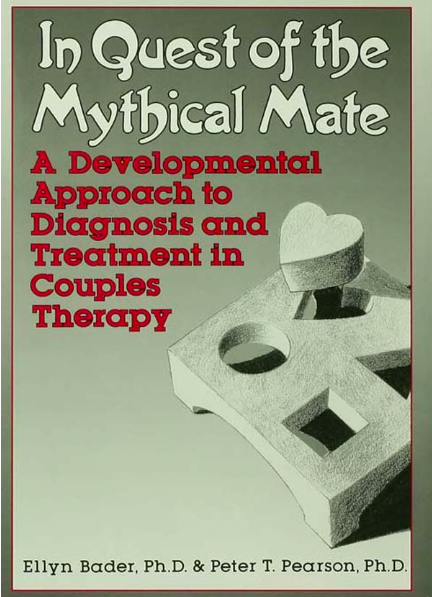
author: ellyn bader
notes in progress
In Quest of the Mythical Mate: A Developmental Approach to Diagnosis and Treatment in Couples Therapy
introduction
Tragedy and even insanity accompany many portrayals of romantic love throughout history. Indeed, falling in love is often viewed as madness. (17)
We have found that the dramas we see daily in our office are much more understandable when they are placed in the context of each partner’s struggle for psychological identity. It is through a deeper understanding of the goals implicit in each individual’s struggles that we can intervene to help the couple create a more effective relationship. (20)
ch. 1: A developmental model of relating
Rather than beginning the therapeutic process with a thorough exploration of childhood influences, we begin with the couple’s current behavior and experiences. (26)
During the symbiotic stage, there is a great deal of passion and mutual giving and receiving. The amount of nurturance is extraordinarily high. This is a prime attraction of this stage. There are few demands or requests of the other person to change. Usually there are special efforts to accommodate and please one another. The child within each person feels responded to at so many levels that it makes it easy to give unconditionally to the other person. (33)
To determine what underlies the couple’s current difficulty, we look at which developmental issues each individual is struggling to maintain or overcome. Thus, we diagnose the couple’s system by looking at where we perceive each individual to be in the developmental phases of the relationship. (39)
It is important to stress that this model places neither partner in an “identified patient” position. It is not a medical model. Instead, it is a means by which the struggles and tensions of a couple’s relationship can be viewed in the larger context of each individual’s search for psychological wholeness. (40)
ch. 2: diagnosing the couple’s stages
We have observed that couples who find it very difficult to maintain eye contact when talking to each other, or find it difficult to maintain eye contact when requested to look at each other when one is talking about the other, often change at a very slow pace. These individuals operate from an undifferentiated position in which their early experience as a child is projected onto the partner. Instead of “taking in” here-and-now cues from seeing what the partner is saying, the internal past experience dominates. (44)
Eye contact can increase merger anxiety. Indeed, some clients report feeling very unbalanced or confused as they look at their partners and talk to them at the same time. This indicates the fluidity of their boundaries and how difficult it is to maintain self in the face of even a positive emotional exchange with the partner. (45)
Each partner is requested to ask and respond to the following Question of Attunement:
What can I do this coming week to make your week go a little bit better or make you feel more loved, valued, and appreciated? (53)
What initially attracted you to each other? How did you decide to get married or live together? Asking about the original attraction evokes both the real elements and the fantasy illusions that were part of the couple’s initial bonding experience. Such information often provides clues to aspects of the problem the couple remain unaware of or are unable to resolve between themselves. (59)
The disillusionment represents the loss of the initial fantasy. Is the loss minimal or substantial, and when did it occur? (62)
If your marriage were a drama, movie, or book, what would it be titled? How would it end? This is a marvelous question and will often give the therapist the most salient feeling-tone of the relationship in a few words that draw a crystal-clear picture. (67)
ch. 3: treating couples in a developmental model
Action results from our desires, and the stronger the desire, the stronger will be the accompanying action. (86)
Changing a significant affect, belief, or behavior pattern with the sole goal of reducing the partner’s nagging is a prescription for failure. As we discussed earlier in this chapter, the impetus for change must arise within each partner in a uniquely self-connected and autonomous manner. (91)
The ability to identify and express desires, thoughts, values, and feelings. This ability is the hallmark of the differentiation stage. It requires a willingness to be vulnerable and the effort to take time to focus inward. It also often requires that one or both partners surmount long-held feelings of inadequacy in verbalizing what they are experiencing. (98)
ch. 4: the symbiotic-symbiotic couple: enmeshed type
Symbiotic partners try to read each other’s minds and do what they imagine the other wants. As these patterns repeat themselves over the years, each partner becomes less aware of his or her own thoughts and feelings; each partner’s behavior becomes almost entirely reactive in nature. (102)
Long-term symbiotic-enmeshed couples rarely present themselves requesting couples therapy. It is much more common for them to arrive with a severely symptomatic child, or with depression in one partner who appears to be the identified patient. (107)
It is usually much easier to move short-term enmeshed couples into the differentiation stage because their primary difficulty is fear of losing the relationship if the conflict surfaces. Once they feel assured that each of them is committed to seeing whether the differences are resolvable, they no longer hold on so tenaciously to the symbiotic stage. (118)
